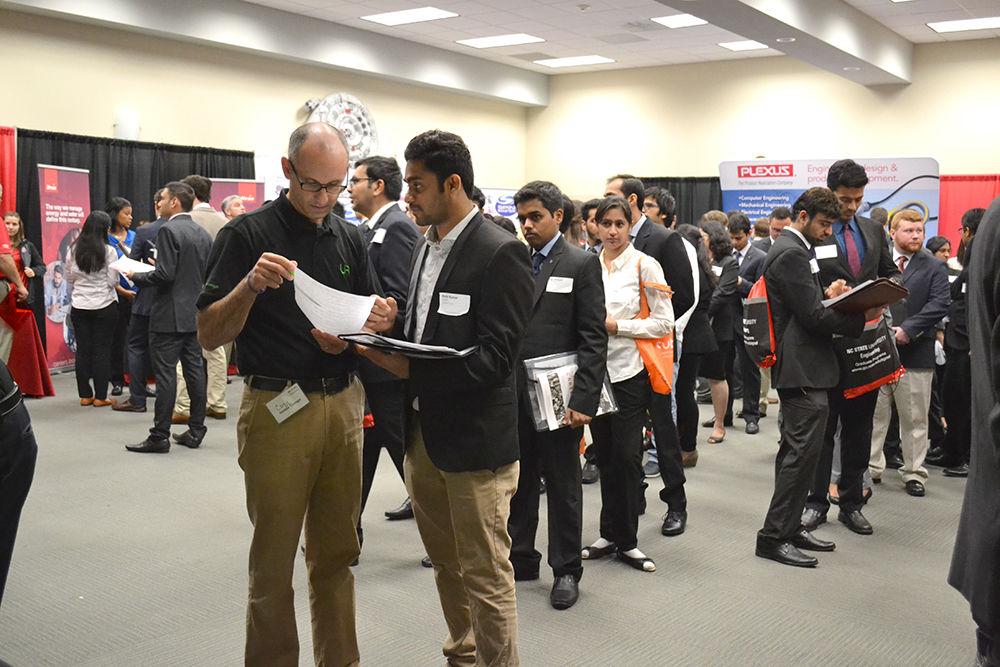Brie Plato was browsing LinkedIn for internship opportunities when she stumbled upon a video internship with SAS. She sent her resume through the quick apply function on LinkedIn, was invited to an interview the following day and a few days later she received a job offer. Four years later, she accepted a full time position at the same company and now serves as a social media specialist.
There are more than 58 million companies currently listed on LinkedIn, and 52 million people look for jobs on the platform every week. Research shows 122 million people were offered an internship after applying via LinkedIn, and 35.5 million people were hired by someone they connected with on the app.
“Seventy-seven percent of recruiters regularly use LinkedIn,” Plato said. “When you think about a career fair, there might be a couple of companies, but they’re not 77% of 58 million companies — that’s a huge percentage of people who are recruiting on LinkedIn. So, especially as a college student, looking for an internship or a job, LinkedIn is the place to be.”
Plato said even if you’re not looking to get hired at the moment, LinkedIn is a great platform to network and join groups that provide knowledge in your field of interest.
“Besides connecting with your peers and family, you can also connect with professors, academic advisors, mentors and people that could potentially hire you,” Plato said. “And these professionals may be willing to connect you with other professionals and their networks who align with your career goals or future job markets.”
Zedrique Ahmed, a fourth-year studying business administration and NC State American Marketing Association president, said some students might refrain from networking on LinkedIn because they might feel uncomfortable messaging new people.
“They might think the person they are reaching out to believes they’re just using them to get a job,” Ahmed said. “But the truth is, most people are going to be helpful as long as you approach them in the appropriate manner and show genuine interest.”
Plato said some acceptable messages for recruiters or other professionals on LinkedIn are based on your approach.
“If it’s someone you’ve met before or someone you’ve been connected with, remind them how they know you,” Plato said. “If you’ve never met the person before, address that and let them know if you’re looking to meet instead of just cold messaging them.”
Since LinkedIn is a social media platform like Facebook and Instagram, being active and posting content is essential. Plato suggests using the “rule of thirds” when posting on LinkedIn, which means posts should include three components: professional content, personal content and passionate content.
“You can, for example, share that you just got married and took time off but you’re ready to get back to the grind,” Plato said. “It’s important that you try mixing up your content to show that you’re more than just what you’re doing at work.”
Plato and Ahmed both said one or two posts a month is satisfactory, but it is even better to post once a week. Kemmia Ghodrat, a fourth-year studying sociology and communication, said she prefers posting high-quality content less frequently.
“I wouldn’t say you need to quantify it,” Ghodrat said. “I’d say it’s quality over quantity. So, if you have quality things to talk about, share those, but don’t post for the sake of posting.”
Ahmed said he used a creative caption to share the new internship position at Red Hat he accepted last summer.
“Try and spice it up a little,” Ahmed said. “The caption I used was ‘Can’t wait to be repping a different type of red and white this summer!’ and I got the most reactions out of all of my posts. I think a lot of people are afraid to get outside of that professional box. They feel like they have to be very uniform when it comes to what they’re posting on LinkedIn, but I think there are ways to show off your personality on it.”
The fear of being rejected is another hurdle keeping students from reaching out to or connecting to people over LinkedIn. Plato encouraged students to look at LinkedIn as a stepping stone that can help them foster their career, rather than focusing on potential rejections.
“I can understand how it can feel scary to contact people — especially when you don’t know them — but the alternative is never reaching out at all and never making that connection,” Plato said. “I know a lot of people that have reached out to a recruiter about a position and didn’t get it. But the recruiter later contacted them about an available option. So make the connection because you never know down the line what it will lead to.”
For more information on creating your LinkedIn, visit its website.













